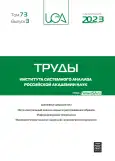Parasite-host system with distributed immunity retention time
- Authors: Gerasimov A.N.1, Sycheva N.V.1, Tsygankova A.E.2, Shpitonkov M.I.3
-
Affiliations:
- Central epidemiology institute
- I.M. Sechenov First Moscow State Medical University
- Federal Research Center “Computer Science and Control” of Russian Academy of Sciences
- Issue: Vol 73, No 3 (2023)
- Pages: 92-102
- Section: System analysis in medicine and biology
- URL: https://journal-vniispk.ru/2079-0279/article/view/287321
- DOI: https://doi.org/10.14357/20790279230310
- ID: 287321
Cite item
Full Text
Abstract
A mathematical model of the dynamics of the “parasite-host” system was studied, in which the duration of immunity maintenance is not fixed, but distributed and depends on the characteristics of a particular host organism. It is found that for a contact number greater than one, there exists a unique non-trivial stationary solution that is a global attractor. With regard to the COVID-19 pandemic, this means that if no new variants of the pathogen arise, then under constant conditions, the incidence will stabilize. The impact on the decay rate of small deviations in incidence for the “parasite-host” system with the presence of groups differing in the duration of immunity was studied. It was found that for values R0 corresponding to COVID-19, the solution has the form of a twisting spiral with a period of about a year.
About the authors
Andrey N. Gerasimov
Central epidemiology institute
Author for correspondence.
Email: andr-gerasim@yandex.ru
Doctor of Mathematics
Russian Federation, MoscowNatalia V. Sycheva
Central epidemiology institute
Email: natsy@bk.ru
Junior Researcher
Russian Federation, MoscowAnna E. Tsygankova
I.M. Sechenov First Moscow State Medical University
Email: anna.tsygankova.inf@gmail.ru
Ассистент
Russian Federation, MoscowMikhail I. Shpitonkov
Federal Research Center “Computer Science and Control” of Russian Academy of Sciences
Email: mixash@bk.ru
Ph.D.
Russian Federation, MoscowReferences
- Chang JT, Kaplan EH. Modeling local coronavirus outbreaks. Eur J Oper Res. 2023 Jan 1;304(1):57- 68.
- Hosseini-Motlagh SM, Samani MRG, Homaei S. Design of control strategies to help prevent the spread of COVID-19 pandemic. Eur J Oper Res. 2023 Jan 1;304(1):219-238.
- Kopfová Jana, Nábělková Petra, Rachinskii Dmitrii, Rouf Samiha C. Dynamics of SIR model with vaccination and heterogeneous behavioral response of individuals modeled by the Preisach operator. J Math Biol. V. 83. № 2. 2021. P. 199-207.
- Mustapha U.T., Hincal E., Yusuf A., Qureshi S., Sanlidag T., Muhammad S.M., Kaymakamzade B., Gokbulut N. Transmission dynamics and control strategies of COVID-19: a modelling study. Bulletin of the Karaganda University. Mathematics Series. 2021. № 2 (102). Р. 92-105.
- Pani Arianna, Cento Valeria, Vismara Chiara, Daniela Campisi, Federica Di Ruscio et. al. Results of the RENAISSANCE Study: REsponse to BNT162b2 COVID-19 vacciNe-short- And long-term Immune reSponSe evAluatioN in health Care workErs. Mayo Clin Proc. 2021 Dec;96(12):2966-2979.
- Sun Q, Miyoshi T, Richard S. Analysis of COVID-19 in Japan with extended SEIR model and ensemble Kalman filter. J Comput Appl Math. 2023 Feb;419:114772.
- Yousef A, Bozkurt F, Abdeljawad T, Emreizeeq E. A mathematical model of COVID-19 and the multi fears of the community during the epidemiological stage. J. Comput. Appl. Math. 2023 Feb;419:114624.
- Wells C.R., Fitzpatrick M.C., Sah P., Shoukat A., Pandey A., El-Sayed A.M., Singer B.H., Moghadas S.M. & Galvani A.P. (2020). Projecting the demand for ventilators at the peak of the COVID-19 outbreak in the USA. The Lancet. Infectious diseases, 20(10), 1123–1125.
- Gerasimov A.N., Razzhevaykin V.N. Dinamika epidemicheskogo protsessa v geterogennoy ne polnost’yu izolirovannoy populyatsii s uchetom sezonnykh kolebaniy aktivnosti mekhanizma peredachi [Dynamics of the epidemic process in a heterogeneous incompletely isolated population, taking into account seasonal fluctuations in the activity of the transmission mechanism]. Zhurnal vychislitel’noy matematiki i matematicheskoy fiziki. [Journal of Computational Mathematics and Mathematical Physics], V 48, 2008№8. P. 1488- 1499
- Gerasimov A.N. Mathematicheskie modeli i epidemiologicheskii analiz. [Mathematical models and epidemiological analysis]. Vestnik Rossiiskoy akademii meditsynskyhk nauk. [Bulletin of the Russian Medical Academy of Sciences], № 12. 2010, P. 23-26.
- Krotkova E.N., Tsyrkunov V.M. Infektsionnye bolezni: dokovidnye i postkovidnye aspekty. [Infectious diseases: pre- and post-cortical aspects]. Sovremennye problemy gigieny, radiatsionnoi i ekologicheskoi meditsiny.[Modern problems of hygiene, radiation and environmental medicine]. V. 10. 2020. P. 426-442.
- Pshenichnaya N.Yu., Lizinfeld I.A., Zhuravlev G.Yu, Ploskireva A.A., Erovichenkov A.A., Akimkin V.G. Epidemicheskii protsess COVID-19 v Rossiiskoi Federatsii: promezhutochye itogi. [The epidemic process of COVID-19 in the Russian Federation: interim results.]. Soobshcenie 2. Infektsionnye bolezni.[Message 2. Infectious diseases]. V. 19. № 1. 2021. P. 10-15.
- Sokolov A.V. Covid-19: kachestvennoye izmeneniye povedeniya sistemy «virus protiv cheloveka» – ot predel’nogo tsikla k ustoychivomu fokusu (preprint) [A Qualitative Change in the Behavior of the “Virus Against Human” System – from Limit Cycle to Sustainable Focus (preprint)]. https://doi.org/10.1101/2022.09.28.22280472
- Starodybov V.I., Beregovykh V.V., Akimkin V.G., Semenenko T.A., Ugleva S.V., Avdeev S.N. i dr. COVID-19 v Rossii: evolyutsiya bzglyadov na pandemiyu (chast 1). [COVID-19 in Russia: the evolution of views on the pandemic (Part 1)]. Vestnik Rossiiskoy akademii meditsinskikh nauk. [Bulletin of the Russian Medical Academy of Sciences]. V. 77. No 3. 2022. P. 199-207.
Supplementary files









